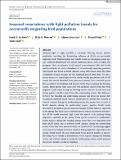Files in this item
Seasonal associations with light pollution trends for nocturnally migrating bird populations
Item metadata
| dc.contributor.author | La Sorte, Frank A. | |
| dc.contributor.author | Horton, Kyle G. | |
| dc.contributor.author | Johnston, Alison | |
| dc.contributor.author | Fink, Daniel | |
| dc.contributor.author | Auer, Tom | |
| dc.date.accessioned | 2022-04-04T16:30:13Z | |
| dc.date.available | 2022-04-04T16:30:13Z | |
| dc.date.issued | 2022-03-31 | |
| dc.identifier | 278722341 | |
| dc.identifier | 5ad99dd6-594e-492d-8195-0d3ba65bcf13 | |
| dc.identifier | 85127518232 | |
| dc.identifier | 000776290300040 | |
| dc.identifier.citation | La Sorte , F A , Horton , K G , Johnston , A , Fink , D & Auer , T 2022 , ' Seasonal associations with light pollution trends for nocturnally migrating bird populations ' , Ecosphere , vol. 13 , no. 3 , e3994 . https://doi.org/10.1002/ecs2.3994 | en |
| dc.identifier.issn | 2150-8925 | |
| dc.identifier.other | RIS: urn:DD205D718E2A3C31571BDFDCEDD292C2 | |
| dc.identifier.other | ORCID: /0000-0001-8221-013X/work/111210394 | |
| dc.identifier.uri | https://hdl.handle.net/10023/25140 | |
| dc.description | This project was supported by The Leon Levy Foundation, The Wolf Creek Charitable Foundation, Lyda Hill Philanthropies, Amon G. Carter Foundation, National Aeronautics and Space Administration (80NSSC21K1143), and National Science Foundation (ABI sustaining DBI-1939187, GCR-2123405). Computing support was provided by the National Science Foundation (CNS-1059284 and CCF-1522054), and the Extreme Science and Engineering Discovery Environment (XSEDE; National Science Foundation, ACI-1548562) through allocation TG-DEB200010 run on Bridges at the Pittsburgh Supercomputing Center. | en |
| dc.description.abstract | Artificial light at night (ALAN) is adversely affecting natural systems worldwide, including the disorienting influence of ALAN on nocturnally migrating birds. Understanding how ALAN trends are developing across species' seasonal distributions will inform mitigation efforts, such as Lights Out programs. Here, we intersect ALAN annual trend estimates (1992-2013) with weekly estimates of relative abundance for 42 nocturnally migrating passerine bird species that breed in North America using observations from the eBird community science database for the combined period 2005-2020. We use a cluster analysis to identify species with similar weekly associations with ALAN trends. Our results identified three prominent clusters. Two contained species that occurred in northeastern and western North America during the breeding season. These species were associated with moderate ALAN levels and weak negative ALAN trends during the breeding season, and low ALAN levels and strong positive ALAN trends during the nonbreeding season. The difference between the breeding and nonbreeding seasons was lower for species that occurred in northern South America and greater for species that occurred in Central America during the nonbreeding season. For species that occurred in South America during the nonbreeding season, positive ALAN trends increased in strength as species migrated through Central America, especially in the spring. The third cluster contained species whose associations with positive ALAN trends remained high across the annual cycle, peaking during migration, especially in the spring. These species occurred in southeastern North America during the breeding season where they were associated with high ALAN levels, and in northern South America during the nonbreeding season where they were associated with low ALAN levels. Our findings suggest reversing ALAN trends in Central America during migration, especially in the spring, would benefit the most individuals of the greatest number of species. Reversing ALAN trends in southeastern North America during the breeding season and Central America during the nonbreeding season would generate the greatest benefits outside of migration. | |
| dc.format.extent | 12 | |
| dc.format.extent | 1579775 | |
| dc.language.iso | eng | |
| dc.relation.ispartof | Ecosphere | en |
| dc.subject | Community science | en |
| dc.subject | eBird | en |
| dc.subject | Light pollution | en |
| dc.subject | Nocturnal migration | en |
| dc.subject | Seasonal bird migration | en |
| dc.subject | Western hemisphere | en |
| dc.subject | G Geography (General) | en |
| dc.subject | QA Mathematics | en |
| dc.subject | 3rd-DAS | en |
| dc.subject | MCC | en |
| dc.subject.lcc | G1 | en |
| dc.subject.lcc | QA | en |
| dc.title | Seasonal associations with light pollution trends for nocturnally migrating bird populations | en |
| dc.type | Journal article | en |
| dc.contributor.institution | University of St Andrews. Statistics | en |
| dc.contributor.institution | University of St Andrews. Centre for Research into Ecological & Environmental Modelling | en |
| dc.identifier.doi | 10.1002/ecs2.3994 | |
| dc.description.status | Peer reviewed | en |
| dc.identifier.url | https://esajournals.onlinelibrary.wiley.com/doi/10.1002/ecs2.4113 | en |
This item appears in the following Collection(s)
Items in the St Andrews Research Repository are protected by copyright, with all rights reserved, unless otherwise indicated.

